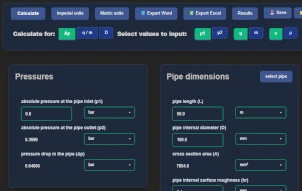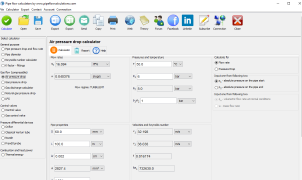Natural gas pressure drop calculator
calculation of natural gas pressure drop or flow rate
Desktop App

Desktop full-featured version.
Free Trial AvailableRegistration
Select a fair price and enable the full service:
- Switch between metric and imperial units in one click
- Export calculation results in Word .docx or Excel .xlsx format
- Preview results on one place and copy/paste it in your favorite text editor
- Send results back to your email
- Support the future of this project
And even more... get access to the full set of 19 desktop calculators available for MacOS, Linux or Windows.
Full Year Service
Prepaid Monthly Cost
$2.50/month
Full year $29.95/year
When Is This Calculator Suitable?
This natural gas pressure drop calculator helps engineers, technicians, and pipeline operators determine pressure losses and flow rates in gas pipelines and distribution networks. It is ideal for evaluating the impact of pipe diameter, fittings, and gas compressibility on natural gas flow.
The calculator is designed for constant-diameter natural gas pipelines and supports both compressible and incompressible flow calculations. Additionally, it considers pressure drop due to local resistances, such as valves and fittings, which play a crucial role in maintaining efficient gas distribution.
Additional Features: Burning Gas Heat Power and LNG Vaporization Energy
This online calculator also provides an estimation of burning gas heat power, which is essential for assessing the energy output of natural gas combustion. The heat power calculation helps in determining the efficiency of gas appliances, burners, and industrial heating processes.
Another key feature is the ability to calculate the energy required for LNG vaporization. This is crucial in liquefied natural gas (LNG) applications where stored LNG needs to be converted back into gaseous form. The tool helps users estimate the energy demand for vaporization, ensuring efficient LNG regasification operations.
Pipe Wall Thickness Calculation
The calculator also includes an option to calculate pipe wall thickness based on the internal pressure and the specified minimum yield stress of the pipe material. This feature is useful for ensuring the structural integrity of pipelines.
It supports calculations for different pipe materials, including:
- Carbon steel
- Stainless steel
- Copper
- PVC
The pipe wall thickness calculation is based on the ASME B31.8 standard and provides three types of calculations:
- Minimum required pipe wall thickness
- Actual stress in the pipe
- Verification of pipe wall thickness for a given permissible stress value
To perform these calculations, users need to input the gauge pressure of the fluid inside the pipe along with either the outer or inner diameter of the pipe.
Limitations of the Natural Gas Flow Rate Calculator
This version of the calculator does not account for pressure variations due to elevation changes in the pipeline. If your gas distribution system involves significant height differences, additional calculations will be required.
How Is the Natural Gas Calculation Performed?
The tool calculates natural gas pressure drop, flow rate, and pipeline diameter based on isothermal gas flow formulas. It assumes a constant gas temperature due to heat exchange with the surrounding soil or air.
Two primary calculation methods are used:
- The Compressible Isothermal Equation – Best for long pipelines with minimal temperature variations.
- The Renouard Formula – Commonly used for practical gas pipeline design.
Standard Conditions for Calculation
For flow rate calculations, the tool determines the gas volume at standard conditions:
- Pressure: 101,325 Pa (14.7 psi)
- Temperature: 15°C (59°F) for metric units, 60°F for imperial units
If you are calculating natural gas pressure drop, enter the flow rate under these standard conditions. The calculator will display the actual flow velocity for the specified pipe diameter.
When Is This Natural Gas Pressure Drop Calculator Not Suitable?
This calculator is not recommended for cases where pressure changes occur suddenly, leading to adiabatic flow conditions. In such cases, more advanced modeling techniques may be required.
Understanding natural gas flow in your pipeline helps optimize gas distribution, reduce energy losses, and ensure safe pipeline operation.
Desktop App

Fast. Accurate. Reliable.
Features in desktop app
- Save/Open multiple results
- Export to Word and Excel
- Print results
- Create list of custom fluid properties
- Resistance factor K for valves/fittings
- Pipe surface roughness selection
- Pipe material selection
- Gauge vs absolute pressure toggle
- Compressible isothermal flow
- Dry air isothermal flow
- Gas offtake flow
- Natural gas flow
- No admin rights required to install
Need a helping hand?
Powered by natural intelligence - NI

If you need a quick calculation, but you are not still familiar how to use the calculator, you can order calculation service from the calculator developer.





